Dorchester, Dorset, England, UK 作者: 来源: 发布时间:2021-07-27
I. Population and Area
Continent: Europe
Country: The U.K
State/Province: England
City/Town: Dorchester, Dorset
Total Area: 6.4 (sq mi)
Population in 2011: 19.1 (thousand)
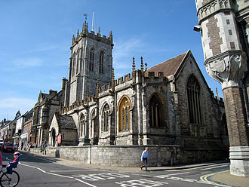
II. Natural Geography (environment and resources)
Terrain
Dorchester town centre is sited about 55 to 80 metres (180 to 262 ft) above sea-level on gently sloping ground beside the south bank of the River Frome. Measured directly, it is about 7 miles (11 km) north of Weymouth, 18 miles (29 km) SSE of Yeovil in Somerset, and 20 miles (32 km) west of Poole. The town's built-up area extends south, west and southeast of the town centre; to the north and northeast growth is restricted by the floodplain and watermeadows of the river.
Rail
The town has two railway stations. Dorchester South is on the South Western Main Line to Bournemouth, Southampton and London Waterloo is operated by South Western Railway; Dorchester West, designed by Isambard Kingdom Brunel, is on the Heart of Wessex Line, operated by Great Western Railway and connects with Yeovil, Bath, Bristol, Gloucester and London Paddington. As part of the regeneration at the Brewery Site in the town centre, Dorchester South railway station will become the first solar powered railway station in the UK.
Road
Mowlem completed a bypass road to the south and west of the town in 1988, diverting through traffic using the A35 and A37 roads away from the town centre. Dorchester is approximately 43 miles (69 km) south east of junction 25 of the M5 motorway at Taunton.
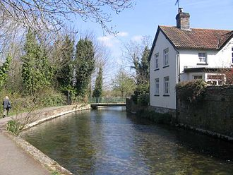
III. Economy
The results in full
Region | GDP 2013 (£m) | Country |
Dorset & Somerset | 28,195 | El Salvador & Honduras |
East of England | 900,568 | Mexico |
East Anglia | 59,368 | Ecuador |
East Midlands | 99,096 | Bangladesh |
The ACS Survey estimates there are 40,443 households in the neighborhood of Dorchester, the per capita income of $22,120 and a median income of $44,136. 13.1% or 5,286 households have reported income of less than $10,000.
Reference Website:
https://www.google.com/search?ei=2bFUX-zgBuWS0PEP1KyH4AI&q=gdp+of++Dorset&oq=gdp+of++Dorset&gs_lcp=CgZwc3ktYWIQA1DPwRFYi9QRYNrZEWgAcAB4AIAB6AKIAZ4YkgEGMi0xMi4xmAEAoAEBqgEHZ3dzLXdpesABAQ&sclient=psy-ab&ved=0ahUKEwissfy1odTrAhVlCTQIHVTWASwQ4dUDCA0&uact=5
IV. Industrial Characterisitics
Major industries:
In the later medieval period the town prospered; it became a thriving commercial and political centre for south Dorset, with a textile trading and manufacturing industry which continued until the 17th century.
In the early years the town's main industry was farming and during the 16th and 17th centuries it had a successful wool industry but in the 18th century it died out due to competition with northern towns. However in the 18th century Dorchester became known for its brewing industry.
Major projects and related introductions:
Dorset Green Living Project
We have been awarded nearly £10,000 by the National Lottery Community Fund to support our exciting new Dorset Green Living Project. The aim of this one-year pilot project will engage groups of neighbours to work together to reduce their carbon footprint whilst saving money on their bills and building stronger local communities. The new funding from The National Lottery Community Fund has enabled us to set up the Project and recruit a coordinator, Rachel Lamb, who began work September 2019.
Since the release of the IPCC report last September, when scientists warned that ‘the 1.5C goal will require a drastic cut in greenhouse emissions’ within 12 years to avoid runaway climate change, ‘eco-anxiety’ has been on the rise. In Dorset people are becoming increasingly worried that failure to act will result in more flooding or wildfires ruining our precious countryside and causing severe food shortages and price rises. With greater focus on climate change and its impacts along with a heightened awareness in plastic contaminating the plastic, people are looking at ways that they can reduce their own impact.
Reference Website:
https://www.sustainabledorset.org/green-living-project/
V. Attractions
1. Hardy’s Cottage:
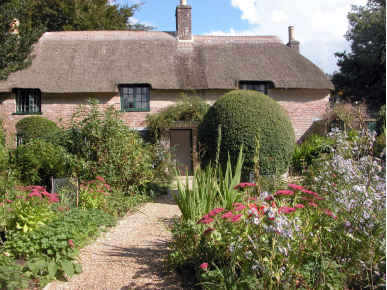
This quaint cottage was the home of Thomas Hardy from his birth in 1840 until he turned 34 and married Emma Gifford. During this time Hardy wrote Far from the Madding Crowd (1874) and Under the Greenwood Tree (1872). This delightful cob and thatch building was constructed by Hardy’s great-grandfather in 1800 and is in the care of the National Trust.
2. TDorset County Museum:
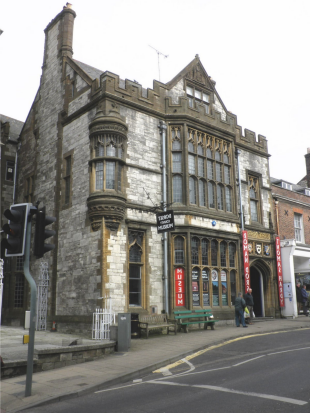
Hardy was one of the founders of the Dorset County Museum, which moved into this stunning purpose-built Neo-Gothic hall in 1881. The museum holds the Thomas Hardy archive, which has pieces like the handwritten manuscript for The Woodlanders and an 1874 first edition of Far from the Madding Crowd.
3. The Keep:
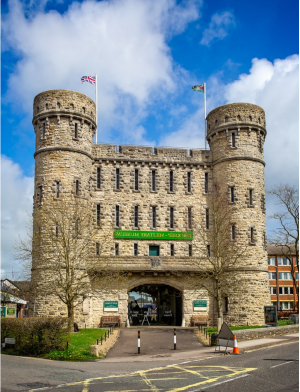
Not as old as it looks, the Keep belongs to the Dorchester Depot Barracks, built in a Tudor Revival style between 1877 and 1881. Although most of the barracks has since been redeveloped this building stayed in Ministry of Defence’s hands after the Dorset Regiment merged with the Devonshire Regiment and moved out in 1958. It now holds the military museum for three British Army regiments (Dorset, Devonshire and the regiment formed when they combined), as well as yeomanry regiments and the older Dorset Militia.
Reference Website:
https://www.thecrazytourist.com/15-best-things-to-do-in-dorchester-dorset-england/
VI. History
Prehistory and Romano-British
Dorchester's roots stem back to prehistoric times. The earliest settlements were about 2 miles (3.2 km) southwest of the modern town centre in the vicinity of Maiden Castle, a large Iron Age hill fort that was one of the most powerful settlements in pre-Roman Britain. Different tribes lived there from 4000 BC. The Durotriges were likely to have been there when the Romans arrived in Britain in 43 AD. The Romans defeated the local tribes by 70 AD and established a garrison that became the town the Romans named Durnovaria, a Brythonic name incorporating durn, "fist", loosely interpreted as 'place with fist-sized pebbles'. It appears to have taken part of its name from the local Durotriges tribe who inhabited the area.
Medieval
One of the first raids of the Viking era may have taken place near Dorchester around 790. According to a chronicler, the King's reeve assembled a few men and sped to meet them thinking that they were merchants from another country. When he arrived at their location, he admonished them and instructed that they should be brought to the royal town. The Vikings then slaughtered him and his men. By 864, the area around Durnovaria was dominated by the Saxons who referred to themselves as Dorsaetas, 'People of the Dor' – Durnovaria. The original local name would have been Dorn-gweir giving the Old English Dornwary. The town became known as Dornwaraceaster or Dornwaracester, combining the original name Dor/Dorn from the Latin and Celtic languages with cester, an Old English word for a Roman station. This name evolved over time to Dorncester/Dornceaster and Dorchester.
Early modern
"The town is populous, tho' not large, the streets broad, but the buildings old, and low; however, there is good company and a good deal of it; and a man that coveted a retreat in this world might as agreeably spend his time, and as well in Dorchester, as in any town I know in England". – Daniel Defoe, in his A tour thro' the whole island of Great Britain (1724–26).
In the 17th and 18th centuries Dorchester suffered several serious fires: in 1613, caused by a tallow chandler's cauldron getting too hot and setting alight; in 1622, started by a maltster; in 1725, begun in a brewhouse; and in 1775, caused by a soap boiler. The 1613 fire was the most devastating, resulting in the destruction of 300 houses and two churches (All Saints and Holy Trinity).
Modern
A permanent military presence was established in the town with the completion of the Depot Barracks in 1881. The High West Street drill hall was created, by converting a private house, around the same time.Land was developed for housing outside the walls including the Cornwall Estate, between the Borough Gardens and the Great Western Railway from 1876 and the Prince of Wales Estate from 1880. Land for the Victoria Park Estate was bought in 1896 and building began in 1897, Queen Victoria's Diamond Jubilee year. The lime trees in Queen's Avenue were planted in February 1897.Poundbury is the western extension of the town, constructed since 1993 according to urban village principles on Duchy of Cornwall land owned by Prince Charles. Being developed over 25 years in four phases, it will eventually have 2,500 dwellings and a population of about 6,000. Prince Charles was involved with the development's design. Dorchester became Dorset's first Official Transition Initiative in 2008 as part of the Transition Towns concept. Transition Town Dorchester is a community response to the challenges and opportunities of peak oil and climate change
VII. Culture
Writers
Novelist and poet Thomas Hardy based the fictional town of Casterbridge on Dorchester, and his novel The Mayor of Casterbridge is set there. Hardy's childhood home is to the east of the town, and his town house, Max Gate, is owned by the National Trust and open to the public. Hardy is buried in Westminster Abbey, but his heart was removed and buried in Stinsford.
William Barnes, the West Country dialect poet, was Rector of Winterborne Came, a hamlet near Dorchester, for 24 years until his death in 1886, and ran a school in the town. There is a statue of Hardy and one of Barnes in the town centre; Barnes outside St. Peter's Church, and Hardy's beside the Top o' Town crossroads.
John Cowper Powys's novel Maiden Castle (1936) is set in Dorchester and Powys intended it to be "a Rival of the Mayor of Casterbridge. Powys had lived in Dorchester as a child, between May 1880 and Christmas 1885, when his father was a curate there. Then, after returning from America in June 1934, he had lived at 38 High East Street, Dorchester, from October 1934 until July 1935, when he moved to Wales. The building is commemorated with a plaque erected by the Dorchester Heritage Committee, but giving the date of his residence as 1936.
Performing arts and museums
Dorchester Arts, based in a former school building, runs a seasonal programme of music, dance and theatre events, participatory arts projects for socially excluded groups and the biannual Dorchester Festival. Dorchester Arts is an Arts Council 'National Portfolio organisation'. Dorchester Arts has been resident at the Corn Exchange since 2015.
Dorchester museums include the Roman Town House, the Dinosaur Museum, the Terracotta Warriors Museum, the Dorset Teddy Bear Museum, the Keep Military Museum, Dorset County Museum. and the Tutankhamun Exhibition. All of these museums took part in the "Museums at Night" event in May 2011 in which museums across the UK opened after hours. The Durnovaria Silver Band is based in Fordington Methodist Church Hall.
VIII. Other information
Dorchester has thirteen first schools, three middle schools:St Osmund's Church of England Middle School, St Mary's Church of England Middle School, Puddletown and Dorchester Middle School and an upper school; The Thomas Hardye School which was founded in 1569 and endowed by Thomas Hardye, a merchant in 1579. It was expanded and reopened in 1888. In 2011 had 2,283 pupils on the roll. The author Thomas Hardy, a distance relative, was a school governor here from 1909 until shortly before his death. The nineteen schools in the Dorchester area form the Dorchester Area Schools Partnership (DASP). There is also a private school, Sunninghill Prep School,
Kingston Maurward College is a land-based studies college on the outskirts of the town. It offers full-time and part-time courses, apprenticeships and university-level courses in a wide range of subjects including agriculture, horticulture, conservation, construction, countryside and wildlife management.
The town's hospital is Dorset County Hospital on Williams Avenue. It offers a twenty-four-hour accident and emergency treatment with services being provided by Dorset County Hospital NHS Foundation Trust.
IX. Contact information
Mayor/Officer: Richard Biggs
Tel: 01305 221000
Mail: enquiries@ageuknswd.org.uk
Reference Website:
https://www.google.com/search?ei=Da9UX43KDYzA0PEP6v2f2AI&q=mayor+of++Dorchester%2C+Dorset&oq=mayor+of++Dorchester%2C+Dorset&gs_lcp=CgZwc3ktYWIQAzIFCCEQoAFQjvIjWI7yI2Cg9iNoAHAAeACAAYYCiAGCBJIBAzItMpgBAKABAqABAaoBB2d3cy13aXrAAQE&sclient=psy-ab&ved=0ahUKEwjNhM7gntTrAhUMIDQIHer-BysQ4dUDCA0&uact=5
https://www.dorsetcouncil.gov.uk/contact/county-hall-dorchester.aspx
